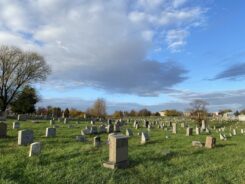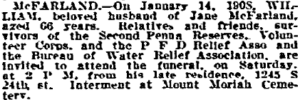Title: Army Private, POW, Civil War; watchman
Birthdate: December 26, 1941
Death Date: January 14, 1908
Plot Location: Section 121, Lot 127

The 1850 census shows that William was the youngest of three children born to Irish immigrants and the first in his family to be born in America. The next enumeration says he was a “brickyard boy” where his brother was a brick maker.
When the Civil War erupted in the spring of 1861 the call for recruits received an overwhelming response in Pennsylvania. The federal government accepted 14 regiments but there were twice that many that enlisted, so the governor wanted to retain them. The legislature agreed, and the men were trained and equipped at state expense. William was in Company E of the 2nd Pennsylvania Reserve Regiment. After many early losses by the Union, more men were needed, so it wasn’t long before the state’s regiments became federalized and the “reserve” label was dropped. The 2nd Regiment became known as the 31st Pennsylvania Volunteer Infantry.
They trained, marched, and camped in Maryland in defense of Washington, D.C. until they were made part of the Army of the Potomac in the spring of 1862. William served under Major William “Buck” McCandless, who led the regiment during the Seven Days Battles near Richmond in late June. (He is also buried at Mount Moriah, and his rise to Colonel and career in politics is part of his “Notable” life story, which can be found here.)
There were seven battles on those seven days, but on the second day, at Mechanicsville, Virginia, William was wounded and captured. There‘s no record of where or how long he was held as a prisoner or when he was returned. He was probably part of a prisoner exchange, and he was mustered out with his company at the end of their three-year term on June 16, 1864.
William wasted no time in taking Jane Dunlap as his bride, exchanging vows at Salem Methodist Episcopal Church on October 3rd of that year. As one of six children of Irish immigrants, she was used to a large family, and would give birth to nine of her own. Their only son, James, was born September 5, 1865, followed by six daughters and two others that didn’t survive infancy.
What William did for a living over the next decade isn’t clear, but his injuries may have played a role. He was a watchman in the 1880s until he filed for a disability pension in 1886. An 1890 Veterans Schedule listed his main infirmity as rheumatism. After that, he was a laborer for the rest of his days.
Three daughters were married before he died and all six outlived their parents. Their only son, James, did not. He was still single and probably living at home when he lost his life as a firefighter in 1894. His “Notable” life story can be found here.
Old wartime injuries can often contribute to the cause of death, but in William’s case, “Epithelioma cancer of right eye” was written on his death certificate in 1908. He was buried in the plot they  bought for their son and was joined later by his wife and two of their daughters.
bought for their son and was joined later by his wife and two of their daughters.

Support the Friends of Mount Moriah
Help us in our mission to restore and maintain the beautiful Mount Moriah Cemetery by donating to our cause or volunteering at one of our clean-up events.

